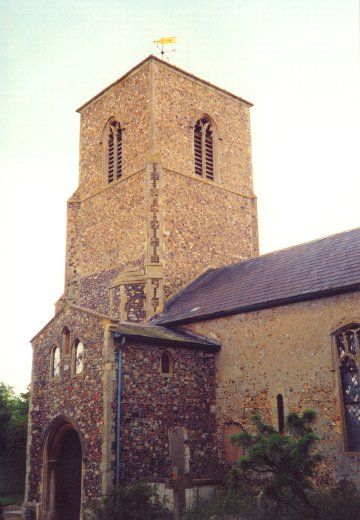
St. Margaret's, Southelmham
The small village of South EImham St. Margaret is situated in the quiet countryside in the north of Suffolk, about five miles south of Bungay. It is one of the six parishes called South Elmham (or Southelmham) and these, together with the four Ilketshalls nearby, are known locally as the 'Saints'.
Saint Margaret's church stands near the road which bends to go round the churchyard. The core of the nave dates from at least Norman times, as revealed by the crude, 'erratic' masonry in the south-east corner (which may be even earlier), also the small window in the south wall and the south doorway. The tower and chancel were probably built during the 14th century and the Perpendicular windows were added during the 15th century.

The square west tower dates from the early 14th century. It appears somewhat incomplete for it has no parapet. Around the base are pleasant trefoill-headed flushwork panels and at the foot of the western buttresses is some fine stone-carving: a shield on the south-west and a carved motif within a lozenge on the north-west. The two-light Decorated west window has been renewed, as has the square-headed single window above it, but on the north and south sides are small square windows. These are common in Norfolk and are known as sound-holes. That on the south has a quatrefoil pattern and in the northern one is an ocffoil pattern. The simple two-light belfry windws are in the Decorated (14th century) style and above, on the north side is a mediaeval gargoyl. In the south-east corner is the staircase turret, which still retains its tiny original windows.
On the north side of the nave are two double Perpendicular windows and a blocked doorway with a renewed head to the arch. The vestry dates from he 19th century, as does the east window of the chancel, which is also in the Decorated style.
On the south side, the chancel has two Perpendicular windows and a renewed priest's doorway. The nave on this side has another two-light Perpendicular window, and, also, a small Norman slit window. Into the wall nearby has been placed an 18th century headstone (1729) and another, with a Latin inscription (1742) can be seen in the east wall of the porch.
The south porch has two storeys. Its upper floor is a parvise, or priest's room, and is lit by single windows. The outer entrance arch has been renewed, as has the niche above it. In the stonework of the western quoin of the south wall are the remains of three mediaeval mass-dials, of which one is quite well preserved. Access to the upper chamber is by a belfy staircase. Inside are the remains of a simple Jacobean bench. The south doorway is Norman, at least 800 years old. It has a simple arch with roll moulding, resting upon volute capitals. Nearby are preserved the old village stocks.
The south door gives access to an interior which is bright and clean. Between the nave and the tower is a handsome tower arch, which is lofty and beautifully moulded. A small doorway gives access tot he belfry stairs. It containts a strong mediaeval door and in the stonework above is carved some interesting graffiti.
The nave is crowned by a mediaeval arch-braced roof, built of oak and having a nicely carved comice. The shields, depicting the emblems of the Passion and other Christian symbols, were added during more recent times. Beside the south doorway is the niche for the fommer holy water stoup. This has a trefoil-headed arch. The 15th century font is of a design common in East Anglia. It is octagonal and round the bowl are the symbols of the four Evangelists, alternating with angels bearing shields. There are lions around the stem, above which is a band of neurons. The simple font cover is made in the Jacobean fashion. The seating is 19 century but beside the north wall of the nave are preserved seven mediaeval bench ends, with poppyheads. The roof loft stairs remain in the north wall. Nearby is an hourglass stair.
The chancel contains two mediaeval features of interest. To the south of the altar are two panels from the base of the former rood screen. They are greatly decayed, but traces of their original paintings can be seen. That on the left is thought to be St. Hubert and the other figures were probably also bishops. In the north wall is a fine stone-carved Easter Sepulchre, where the Blessed Sacrament was placed form Good Friday Easter, symbolizing Our Lord's burial in the tomb. The recess has a crocketted canopy with a finial and flanking pinnacles, and there is carved tracery with neurons on the base.
The vestry, itself a Victorian addition, contains a large fragment of mediaeval stained glass in the western window. It dates from the 14th century and depicts intricate canopy work with pinnacles. There is an ancient chest, with three locks, a 17th century Holy Table, which probably once served as the High Altar.
Among the Plate possessed by the church is an Elizabethan Chalice, dating from 1576 and inscribed 'Saynte Margetes of Ellmum'. There is an Irish paten, made in 1705, bought second-hand for the church in 1838.
In the tower are five bells, cast by the Brend family in their Norwich factory. One was dated in 1595, another in 1637, and the remaining three in 1657. The registers date back to 1679.
See Suffolk Churches